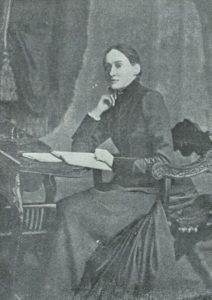“A good English factory-girl”: the erased Irishness of nineteenth-century poet Fanny Forrester in Ben Brierley’s Journal
Dr Suz Garrard

Twenty-first century newspapers and media outlets have unparalleled power to not only shape the narratives surrounding superstructural subjects such as immigration, but to construct the social, political, and national identities of the individuals they represent. The power of the media to radically create and recreate public, political selves can be traced back to the explosion of the nineteenth-century newspaper and, in this case, to the massive influx of Irish labourers to industrial English cities.
On 23 June 1875, Ben Brierley devoted nearly two full pages of his popular, Manchester publication — Ben Brierley’s Journal — to a biography and literary overview of local poet and factory dye-worker Fanny Forrester (1852-1889).[1] Brierley lauds Forrester as a ‘gifted girl’ for ‘writing of fields and flowers as of things with which her earlier years were unacquainted’, and goes so far as to claim that Forrester has never been ‘beyond the range of Peel Park’ and that ‘outward nature has hitherto been a sealed book to her’. He concludes that Forrester’s ‘studies of human life and character have been confined to the experiences of the mill and the dye-house’. The Forrester that Brierley presents to his readers is a modestly talented girl, a literary novelty that is indelibly Mancunian and, by extension, English. According to Brierley, her poetry merely stemmed from a desire to ‘lighten her labour’ and craft a sentimental, pastoral world that would speak to her urban, working-class experiences.[2] She is beloved by the readership of the journal because she and her work are distinctly outside of the political, public realm.
Brierley’s brief biography, however, erases Forrester’s markedly Irish heritage and the significant role that her immediate family members played in the promotion of Irish independence and nineteenth-century nationalist literature. Forrester was the eldest daughter of Ellen, née Magennis, a native of Clones, County Monaghan who had contributed poetry to several local papers in Ireland by the time she emigrated to Liverpool in 1845. After marrying stonemason Michael Forrester and relocating to Manchester in 1847, Ellen had five children in quick succession and struggled to keep her family afloat. In his 1945 examination of Michael Davitt’s notorious ‘Pen Letter’, T. W. Moody claims that Ellen was an ardent Fenian supporter who aided in the organisation of the defence fund for the 1867 ‘Manchester martyrs’.[3] Ellen’s son and Fanny’s younger brother, Arthur, shared his mother’s Irish nationalism and poetic talent. Arthur was arrested several times for Fenian activity in England and Ireland, and he led the failed attempt to siege Chester castle in 1867. He was so well-known amongst Irish sympathists around the globe that his activities were frequently reported in newspapers as far away as San Francisco.[4] Ellen and Arthur’s shared political ideologies led to a published collection of Irish nationalist poems entitled Songs of the Rising Nation in 1869.[5]
Despite the extent of Forrester’s connections to Ireland and Irish nationalist causes, Brierley contains Forrester and her writing within the physical borders of Manchester. He omits Forrester’s mother and brother from the short biography — both of whom were still living at the time of the dedication — only stating that Forrester was ‘left fatherless’ at the age of twelve. The selective erasure of Forrester’s Irish heritage most likely stemmed from two editorial concerns: the need to keep his journal relevant to ‘the simple lives and experiences of the humble people’ of Lancashire and, more importantly, to ‘write’ Forrester into the politically safe identity of a nineteenth-century poetess — a figure neatly contained within the domestic, sentimental, and British traditions of female writing.[6] In a few statements, Brierley ensures that Forrester is received as a working-class version of an L.E.L or Felicia Hemans, two poets whose conforming femininity and loyal Britishness were not in question by Victorian society.[7]
Brierley’s establishment of Forrester as an English factory poetess extends to the overview of her poetry that had appeared in Ben Brierley’s Journal. He praises the poems in which Forrester displays an ‘amatory’ voice. However, the journal had interestingly featured a poem by Forrester that spoke on the highly politicised issue of British sovereignty in Ireland in 1873. Brierley merely states that this poem, entitled ‘Celt and Saxon’, was ‘one of [Forrester’s] shortest poems, which is a production of the ballad type, and quite different in style from anything she had previously written’. The poem features personified versions of Britain and Ireland as ‘A noble Saxon youth’ (2) and ‘an Irish maid, / All innocence and truth’ (3-4).[8] The Celtic maiden both celebrates and laments her love for the Saxon, a love that she states has left her a prisoner:
“I’ve sang for thee the mournful songs
Of fallen Innisfail —
Of fancied wrongs, and real wrongs—
Till, rigid, stern, and pale,
I saw thee rising to defend
The memory of thy dead,
Defying all who sought to bend
Thy haughty Saxon head!
“I’ve promised often to depart,
Yet lingered at thy side,
And wept, upon thy British heart,
Poor Erin’s fallen pride!
Thy bird, that sang of freedom’s charms,
One broken anthem gave,
Then fluttered in thy stalwart arms—
Thy captive, and thy slave! (17-32)
Forrester’s Irish nationalism is couched within the framework of a pastoral, sentimental romance; her Celtic maid is simultaneously submissive and subversive, appealing to the Saxon’s sense of history and justice to allow Ireland more freedom while quietly accusing Britain of wrongdoing. Ireland’s requests in the poem are hardly revolutionary, she asks not for full independence, but a return of some national sovereignty — perhaps calling for the return of Grattan’s Parliament and its associated powers. Forrester, as Ireland, even goes so far as to admit that some of Ireland’s grievances may have been merely ‘fancied wrongs’ (19). However, it is the final stanza of the poem that makes the strongest political statement:
The maiden ceased — the youth bent low,
And clasped her yielding form:
“Mine, mine, he cried, in weal or woe!
Mine, mine, in calm and storm!”
The maiden’s blushing face grew pale,
And, even while she smiled,
She murmured sadly, “Innisfail,
Forgive thy faithless child!” (41-8)
This stanza and the poem raise more questions than they answer: Is this a condemnation of a conquering Britain, or a subtle accusation of the lack of Irish political might? Is the Celtic maiden seeking forgiveness from a historically independent Ireland, or an expression of Forrester’s personal struggles with her own feelings of dislocated allegiance and national identity? Is Forrester advocating for an entirely independent Ireland, or one with more rights to self-governance? With all of these potential readings existing just beneath the conventionally sentimental surface of the poem, it is no wonder that Brierley chose to distance ‘Forrester the house-poet’ from the politically complicated, overtly Irish aspects of the actual Forrester. In fact, Forrester’s already established status as a regular contributor by the time of the poem’s publication is most likely the only reason why the journal included ‘Celt and Saxon’ at all.
Brierley’s dedication of this little-known poet in his regional publication, underscoring how the competing pressures of subscription numbers, production costs, and personal political agendas mediated the narratives of marginalised authors, overdetermining how they and their work were received. This unequal power dynamic is further exacerbated by the medium of the periodical, where the multi-faceted relationships between national, gender, and class identity for nineteenth-century Irish women writers is frequently expressed through more conservative, established frameworks of Victorian writing. ‘Celt and Saxon’ epitomises how the legacy of Irish culture and political allegiance in the post-Famine decades continued to directly influence the children of Irish emigrants in their new homelands, and how the limitations of class and gender shaped Irish women’s diasporic writing as much as the politics of nationalism.[9]
Dr Suz Garrard is a Postdoctoral Research Fellow at University College Dublin, funded by the Irish Research Council. Her current project explores the representation of Irish emigrants and emigration in Dublin and Belfast newspapers throughout the long nineteenth century. She received her PhD from the University of St Andrews in 2017, and an MLitt (Distinction) in Women, Writing and Gender from St Andrews in 2013. She also has a BA (Hons) in English and History (2012) from Southwestern University. Her research interests include the creation of social identity in Victorian periodicals and newspapers, working-class writing, and nineteenth-century women’s poetry.
Would you like to submit a blogpost? Check out our guidelines here or email Dr Deirdre Flynn.
Notes:
[1] Brierley, Benjamin. “Fanny Forrester,” Ben Brierley’s Journal (Manchester, England), 23 June 1875, 37-9.
[2] See Suz Garrard, “And, oh! but the lilies are pure and fair’: Fanny Forrester, Ben Brierley’s Journal, and the Creation of a Working-Class Women’s Pastoral Tradition,” Victorian Periodicals Review 50, no. 3 (Fall 2017): p. 447-66.
[3] T. W. Moody, “Michael Davitt and the ‘Pen’ Letter,” Irish Historical Studies 4, no. 15 (Mar. 1945): 224-53.
[4] “The Manchester Martyrs,” The San Francisco Morning Call (San Francisco: California), 7 September 1890, 15.
[5] Ellen and Arthur M. Forrester, Songs of the Rising Nation (Glasgow & London: Cameron & Ferguson, 1869). For further discussion of Irish nationalism and literary patriotism — including Songs of the Rising Nation, see D. George Boyce, Nationalism in Ireland (London & New York: Routledge, 1982), 231.
[6] Benjamin Brierley, “The Lancashire Dialect,” Ben Brierley’s Journal, December 1871, 3.
[7] See A.K. Mellor, “The Female Poet and the Poetess: Two Traditions of British Women’s Poetry, 1780–1830,” in Women’s Poetry in the Enlightenment, eds. Isobel Armstrong and Virginia Blain (London: Palgrave MacMillan, 1999), 81-98.
[8] Fanny Forrester, ‘Celt and Saxon’, Ben Brierley’s Journal (Manchester: England), March 1873, 169.



